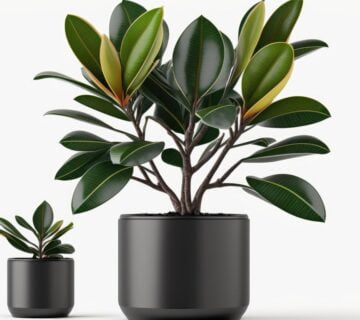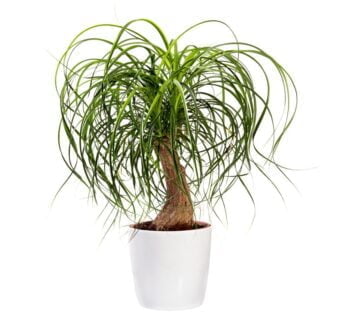Bunny Ear Cactus (Opuntia microdasys)
The Bunny Ear Cactus, scientifically known as Opuntia microdasys, is a charming and popular cactus native to Mexico. It gets its common name from the shape of its pads, which resemble bunny ears.
Appearance:
– The Bunny Ear Cactus has flat, oval-shaped pads covered in clusters of tiny spines called glochids.
– The pads are bright green and grow in a stacked or layered formation.
– The glochids are barbed and can cause irritation, so carefully handle the plant.
– The cactus can produce colourful, yellow or red flowers in the spring or summer, followed by small edible fruits.
Light Requirements:
– Bunny Ear Cacti thrive in bright, direct sunlight. Place them near a south or east-facing window where they can receive at least 4-6 hours of sunlight daily.
– They can tolerate some shade but may become leggy and less compact in appearance.
Temperature and Humidity:
– Bunny Ear Cacti prefer warm temperatures between 70-90°F (21-32°C) during the growing season.
– They can tolerate high temperatures but should be protected from freezing temperatures, as they are not cold-hardy.
– These cacti can adapt to dry indoor environments with low humidity levels.
Watering:
– Bunny Ear Cacti are drought-tolerant and have low water requirements.
– Water them sparingly, allowing the soil to dry out completely between waterings. Overwatering can lead to root rot.
– In the winter, reduce the watering frequency to mimic the plant’s dormant period.
Soil:
– Use a well-draining cactus or succulent potting mix for Bunny Ear Cacti.
– The soil should be loose and gritty to ensure proper drainage and prevent soggy roots.
Fertilization:
– Bunny Ear Cacti have low fertilizer needs and can grow well without regular feeding.
– If desired, apply a balanced, diluted cactus fertilizer once or twice during the growing season to provide some nutrients.
– Avoid fertilizing during the winter months.
Pruning:
– Pruning requirements for Bunny Ear Cacti are minimal.
– Use sharp, clean pruning shears to remove damaged or diseased pads or shape the plant if necessary.
– Take caution when handling the cactus due to the presence of glochids.
Propagation:
– Bunny Ear Cacti can be propagated through stem cuttings.
– Wait until the cut end of the pad calluses over before planting it in well-draining soil.
– Keep the soil moist until roots develop, then gradually reduce watering.
Common Pests and Problems:
– Bunny Ear Cacti are generally resistant to pests and diseases.
– However, they can occasionally encounter mealybugs or scale insects. Treat any infestations promptly with insecticidal soap or neem oil.
Toxicity:
– The glochids on the Bunny Ear Cactus pads can cause skin irritation or discomfort if touched. Take precautions when handling the plant, and consider using gloves.
Things to know about Bunny Ear Cactus (Opuntia microdasys)
Common (vernacular) Name
विंका (Hindi), Vinca, Sadabahar, Madagascar Periwinkle, Catharanthus Roseus, Nityakalyani, Bara Massi, Bright Eyes, Cape periwinkle, Graveyard Plant, Old maid, Pink Periwinkle, Rose Periwinkle, and many more.
Botanical Name
Catharanthus roseus
Origin
Island of Madagascar
Family
Apocynaceae
Plant Type
Tropical plant
Plant Features
Ornamental / Evergreen / Exotic
Life Cycle
Perennial
Landscape Uses
Container, Walkways, Ground Cover, Mass Planting and Houseplants.
Species
Apricot Cooler Improved, Aztec Pink Magic, Blue Pearl, Cascade Beauty White, Cooler Icy Pink, Cooler Orchid, Cooler Peppermint, Cora Burgundy, Cora Cascade Cherry, Cora Cascade Strawberry, Cora Red, Experimental Dee, Jams and Jellies, Mediterranean Lilac, Mediterranean XP Cherry Halo, Mediterranean XP Rose Halo, Nirvana Pink Blush, Nirvana Red, Nirvana Sky Blue, Nirvana Violet, Pacifica White, Sunshower Lilac, Titian Icy Pink
Varieties
It comes with more than 30 varieties in various leaf and flower colourations.
Size
Height : 1 to 1.5 feet tall and Width : 1 foot wide when mature.
Indoors or Outdoors
Outdoors : Anthurium can be used outdoors in shady plantings; avoid direct sunlight.
Indoors : Excellent plant growth in bright light or indirect light. Best indoor plants for beginners.
Blooming / Flowering
The blooming period is throughout the year.
Flower Colour
It’s come in Pink, White, Purple, Red and Multicoloured.
Lucky Plant
According to Feng Shui, It brings Good Luck in your relationships.
Lighting / Sun Exposure
Bright Indirect Sunlight.
Temperature
Grow best in warm temperatures above 21°C and tolerate max temp. as high as 32°C.
Growth Rate
Anthurium is a slow to moderate grower plant.
Watering
Moderate watering, Mist or overhead sprinkler to provide water and to improve relative humidity. Do not tolerate overwatering, It can cause root damage and leaf yellowing.
Fertilizer
Applying slow-release fertilizer or a water-soluble liquid fertilizer once or twice during the growing season (from spring to summer) is recommended.
i.e., - Cow dung, DAP, Compost, NPK 30-10-10 fertilizer, liquid organic fertilizer etc.
Pruning
Pruning of Anthurium, little is needed. However, trimming away only discoloured or dead leaves.
Propagation
Seeds : The best time to sow your Anthurium seeds is at the end of Winter / early Spring, but it can't give good results.
Stem Cuttings : The easier propagation methods of Anthurium in water or soil via stem cuttings can be done during the warm growing season.
Division : The division of Anthurium can be done in the Rainy season or, better, from February to March.
Dormancy Period
Month : November to February (winter season)
Shed their leaves and show poor growth, Watering minimally.
Avoid : Propagate, Fertilize and Repotting.
Container
Ceramic Pot, Plastic Pot, Terracotta or Clay Pot is preferred, which ensures good drainage and water holding capacity.
Soil Type
A well-drained Loam / Coarse potting soil and water-holding capacity are recommended. Prevent soggy potting medium.
Our recommendation for the potting mix: Equal part mixture of Garden Soil (25%) + Compost (25%) + River Sand (25%) + Cocopeat (25%). You can substitute pieces of Charcoal, Vermicompost, Perlite etc.
Soil pH
Lightly Acidic soil - Ideally, 5.5 to 6.5 pH (potential of hydrogen) is recommended for Anthurium.
Repotting
It is advisable to repot the Anthurium every year or two, preferably during the spring to midsummer season.
Maintenance
Low maintenance and easy to grow.
Properties
The plant poses toxicity risks to both humans and pets if ingested.
Benefits
Excellent indoor air purifier, Anthurium plants turn CO2 into oxygen. It purifies indoor air by removing harmful chemicals like ammonia, toluene, xylene and formaldehyde.
Special Features
It does not attract hummingbirds and pollinators in the same way it does butterflies, bees, or wasps.
Infestation / Pests
Aphids, Scale insects, Thrips, Mealybugs, Spider mites, caterpillars etc.
Diseases / Problem
Physiological Problem : Anthracnose, Leaf Spot and Powdery Mildew.
Bacterial Problem : Bacterial Blight, Bacterial Wilt and Black Nose Disease.
Fungal Problems : Root Rot and Water Mold.
In conclusion, Bunny Ear Cacti are delightful and easy-to-care-for plants that can bring a touch of whimsy to your indoor or outdoor space. With their unique appearance and low-maintenance nature, they are an excellent choice for cactus enthusiasts or beginners looking to add some desert beauty to their collection.
Some Glimpse of Bunny Ear Cactus (Opuntia microdasys)





No comment